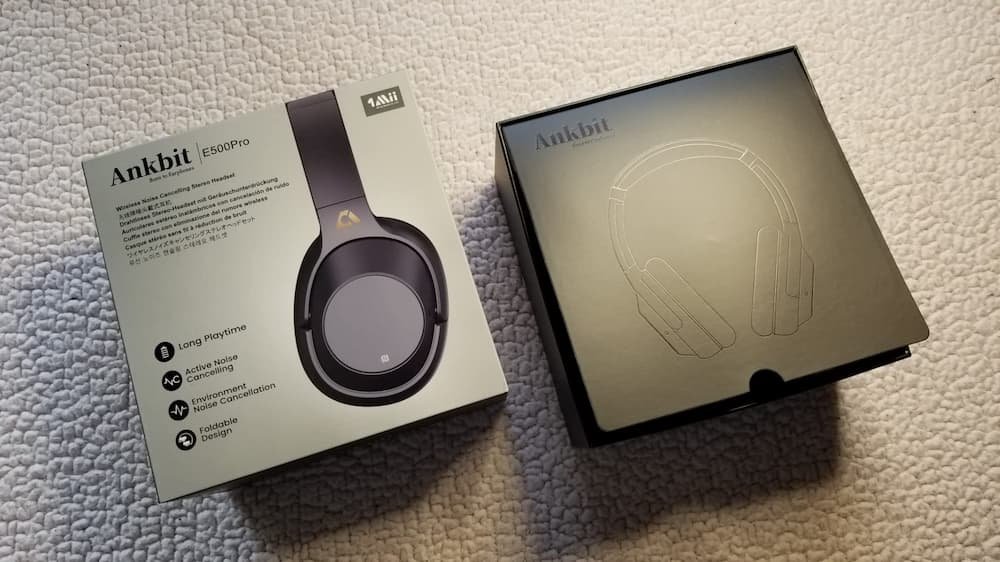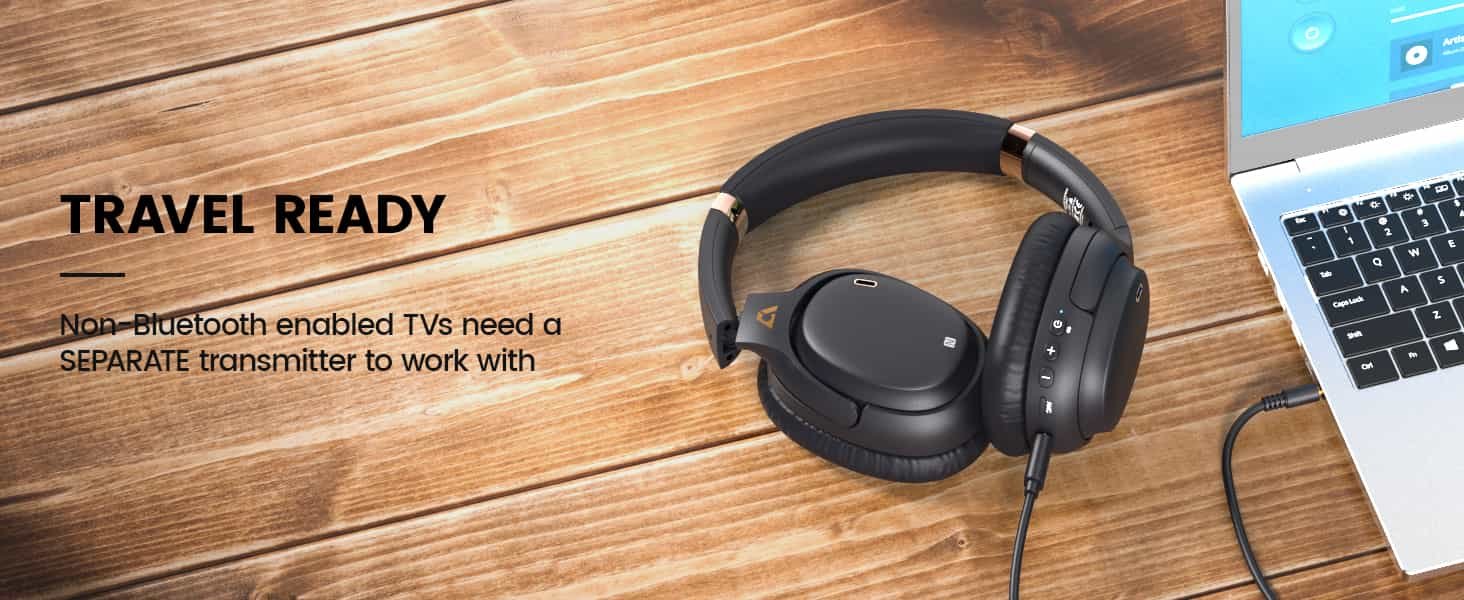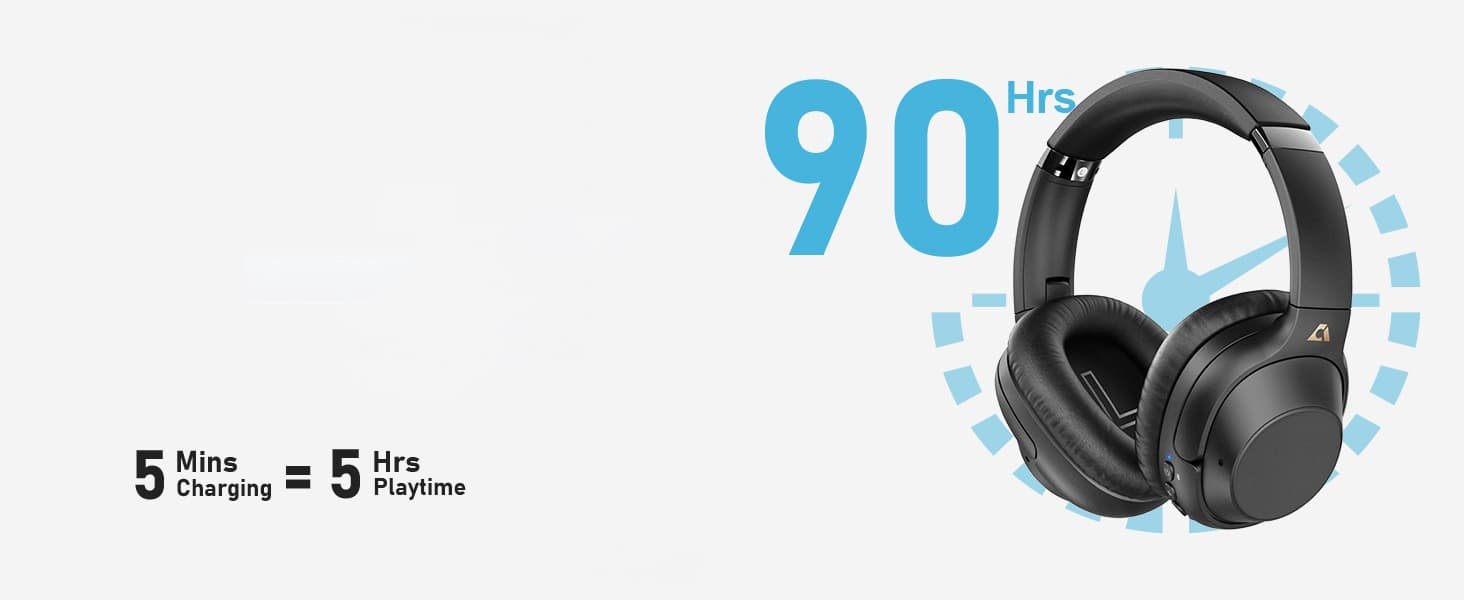The Ankbit E600Pro arrived in an understated black carton about the size of a hardback novel. Inside, a molded cardboard cradle held the headphones in place no plastic clamshells, no twist-ties, no unnecessary brochures. Beneath the cups sat a soft drawstring pouch, a USB-C charging cable, a surprisingly stout 3.5 mm-to-USB-C audio lead, and a one-page quick-start sheet. That’s it, and that’s honestly all you need.
Lifting the headset for the first time, I noticed two things: the matte finish felt more premium than any sub-$70 ANC can has a right to feel, and the weight distribution seemed suspiciously balanced.

The earcups swivel flat right out of the box a nice touch for desk storage and the gold anodized rings where the yokes meet the headband catch just enough light to look intentional, not gaudy. First impression? Ankbit wants budget buyers to feel like they’ve unboxed something grown-up.
Design and Build Quality
Plastic dominates the construction, but it’s the dense, high-quality variety no hollow echo when tapped. A slim stainless-steel band hides beneath the headband padding, giving the frame a reassuring flex without creaks. Both earcups can spin a full 90 degrees to lie flat against a table or chest, though they don’t hinge upward for compact folding.
Cushions are finished in what Ankbit calls “protein leather”; translation: supple synthetic that resists sweat and fingerprints better than entry-level vinyl. The yoke arms travel through eleven discrete clicks, so dialing in extension for larger heads is precise and repeatable. Every moving joint feels damped no loose wobble, no cheap rattle when shaken. After two solid weeks of transport in a backpack, the matte coating still looks factory-fresh, which is more than I can say for a pair of name-brand cans I paid triple for last year.
Comfort Over Marathon Sessions
A headset lives or dies on comfort during hour four of an editing session or a raid night that stretches way past midnight. At 308 grams, the E600Pro isn’t feather-light, but the clamping force is mild and the ear cushions are deep enough that my ears never touch the driver baffle. The headband pad spreads weight evenly across the crown; it’s wide, plush, and stitched so the foam doesn’t bunch up with repeated bending.

Heat build-up stays surprisingly low. I tested during an early-summer spell with ambient temps hitting 27 °C indoors, and I never felt compelled to peel the cups off for a cooldown. If you wear glasses, the pads compress just enough that temple arms don’t create pressure hot-spots, though thicker acetate frames might require a tiny adjustment forward.
Controls and Everyday Handling
Every control lives on the right earcup. A long press on the power button wakes the headset and announces battery level; a single tap toggles ANC. Separate volume rockers sit inboard from a multifunction play/pause key, and their shapes differ just enough that you find them blind after a day’s muscle memory. The buttons depress with a firm, clicky action no mushy membranes here and because there’s no companion app, whatever you press is what happens.
Call management also routes through the play/pause button: single press to answer, double to reject. Simple. No accidental swipes, no false taps. For travelers who hate digging through apps just to adjust sidetone, the E600Pro’s hardware-only philosophy is refreshingly friction-free.
Connectivity, Range, and Latency
Bluetooth 5.1 provides the wireless pipeline, and pairing proved instant on both iOS and Android. More impressive is true multipoint: I kept the headphones tethered to a MacBook Air and a Pixel phone simultaneously. When a Slack call rang in, Spotify on the phone paused automatically and resumed the second I hung up no menu-diving or manual switches.
Range was equally solid. I left the phone in the living room and walked to the kitchen roughly 10 meters and two interior walls before hearing a hiccup. In gaming tests on PC (via a generic USB BT-5.0 dongle) audio latency was low enough that rhythm-game timing windows felt normal; there’s no official low-latency gaming mode, but aptX and aptX HD both keep lips in sync on YouTube and speech videos.
Battery Life in Real Use
Specs promise 80 hours with ANC off and 45 hours with it on. My real-world loop was roughly 60 percent music at moderate volume, 30 percent video editing, and 10 percent voice calls, ANC engaged the whole time. Result: the low-battery beep arrived late on day nine, after a hair over 42 hours of countable playback. Charging from empty to full over USB-C took just shy of two hours on a 10 W wall brick.

Fast-charge isn’t advertised, but a 15-minute top-up yields about three hours of listening, handy when you forget to plug in before a commute. Most astonishing? The E600Pro used less than 10 percent while in idle Bluetooth standby overnight great news for anyone who forgets to power down after Netflix.
Sound-Test Method
I kept things consistent:
- Wireless: Pixel 8 Pro streaming Spotify Premium (Very High / 320 kbps) over aptX HD.
- Wired: FiiO BTR5 DAC/amp via supplied 3.5 mm-to-USB-C cable, running FLAC files at 16-bit/44.1 kHz.
- Reference tracks: Hans Zimmer – “Time,” Billie Eilish – “Oxytocin,” Foo Fighters – “The Pretender,” Daft Punk – “Lose Yourself to Dance,” plus my go-to footstep test, Valorant training map ambience.
Listening volume calibrated to ~75 dB SPL with a mini-DSP EARS rig for apples-to-apples comparisons.
Audio Performance – Wireless Mode
If there’s a signature, it’s a confident V-curve tilted toward bass enjoyment. Sub-bass drops to about 35 Hz before rolling away impressive depth for closed-back Bluetooth cans. Mid-bass adds warmth but stops short of drowning vocals. Billie Eilish’s whispered phrases ride smoothly atop synth rumbles; they never smear into each other.
Mids dip slightly around 400–800 Hz, which lends guitars a softer edge. That’s most obvious in acoustic rock: the strum body of an unplugged Taylor feels a tad recessed. Above 2 kHz, presence and brilliance return, giving cymbals a gentle sizzle without dagger-sharp spikes. There’s a mild treble peak near 8 kHz that adds air, but never reaches sibilant territory unless you crank webcam recordings mastered hot.
Soundstage won’t fool you into thinking open-back, but vertical layering is respectable. In Zimmer’s “Mountains,” strings occupy a distinct loft above the organ swell, and percussion rolls in front rather than merging into a flat wall. Imaging while gaming was tight enough to track flanks in Valorant without stumbling.
Audio Performance – Wired Mode
Plugging into the BTR5 cleans up sub-bass bloom and tightens transient attack. Kick drums in Foo Fighters slam snappier, and that mid dip straightens out a hair, so rhythm guitar sits closer to center-stage. Overall tonality stays familiar still bass-enjoying but wired mode extracts an extra 5–10 percent detail, particularly on hi-hat decay.
Volume overhead also expands. On an iPhone with a USB-C dongle, I rarely needed past 60 percent; peaks remained distortion-free. For purists who demand max fidelity on flights, wired mode is the way to go, but casual listeners won’t feel short-changed sticking to Bluetooth.
Microphone Quality and Chat
Built-in MEMS mics handle voice commendably. Frequency capture sits roughly 100 Hz–7 kHz, so you lose chest heft but gain clarity. Friends on Discord said I sounded “almost like a USB desk mic,” and background keystrokes faded to faint taps. Outdoors, wind rejection was average 30 km/h gusts did introduce buffeting but that’s par for slim bezels without foam socks. Bottom line: perfectly serviceable for meetings and squad chat, just not streamer-grade.
Gaming Experience
Pairing to a Windows PC via aptX offered no noticeable lag in Hades II or Hi-Fi Rush. Positional cues in Valorant landed accurately left-right; vertical info was clear enough to pinpoint Sage walls above or below. The padded seal keeps ambient noise out so well that I once missed a courier at the door proof the ANC does its job.
The bass-forward profile adds drama to explosions and ultimates without obliterating team comms. Combined with the generous battery, I could run a Friday-night raid from 8 p.m. to 2 a.m. and still wake up Saturday with charge left for morning playlists.
Music and Movies
Cinema content benefits from that low-end authority. Sub-woofer swells in Dune’s ornithopter chase shook my jawline without flapping the drivers. Dialogue clarity held steady, even in chaotic scenes. Switching to jazz Miles Davis’ “So What” remaster the muted trumpet floated center while double-bass walked smoothly underneath. The lack of wide stereo spread doesn’t cripple ensemble recordings; it simply trades breadth for intimacy.
For pop playlists, the tuning leans fun. If your library is heavy on acoustic singer-songwriter fare, you might wish for brighter mids; an EQ pedal or system-wide profile at +2 dB around 1 kHz fixes it handily.
Final Verdict
The Ankbit E600Pro sits at that rare intersection where “cheap” stops meaning compromise. It isn’t reference-flat, nor does it pretend to sip battery; it gulps audio for days. Its ANC won’t shame Bose, but it hushes enough to keep you in flow. Build is sturdy, controls are straightforward, and multipoint Bluetooth with aptX HD still feels like magic at sixty-odd dollars.

Could mids be cleaner? Sure. Would an ambient passthrough be handy? Absolutely. Yet those omissions fade after a week of uninterrupted playback and mornings where I realize I forgot the charger again because, well, I didn’t need it. For anyone hunting reliable wireless cans that punch above their ticket price and live comfortably on-head all day, the E600Pro belongs on the shortlist.
Ankbit E600Pro Wireless Bluetooth Over Ear Headphones

The Ankbit E600Pro wireless Bluetooth headphones feature advanced hybrid active noise cancellation with dual ANC chips and five microphones, delivering up to 35dB noise reduction. Equipped with QCC3034, aptX HD, aptX Low Latency, and 40mm drivers, they provide immersive sound, deep bass, and crystal-clear calls with cVc 8.0 technology. Enjoy up to 80 hours of playtime and ultra-soft comfort for travel, work, or home entertainment.
Product SKU: ANKBIT-E600PRO
Product Brand: Ankbit
Product Currency: USD
Product Price: 29.99
Price Valid Until: 2030-12-31
Product In-Stock: InStock
4
The Ankbit E600Pro is available on Amazon.
Pros
- Bass-rich yet controlled sound signature
- AptX HD and true multipoint Bluetooth 5.1
- Marathon battery life (≈45 h ANC-on / 80 h off)
- Comfortable memory-foam pads, low heat build-up
- Solid build with flat-swivel cups and USB-C charging
- Clear microphone for calls and chat
Cons
- Midrange slightly recessed; acoustic instruments lack bite
- Soundstage is tall but not very wide
- No transparency/ambient mode or companion EQ app
- Earpads are stitched, not easily replaceable
- ANC effective but short of premium flagships